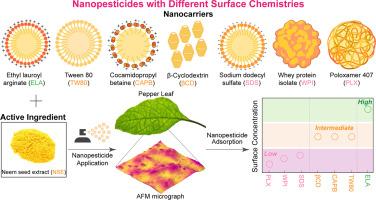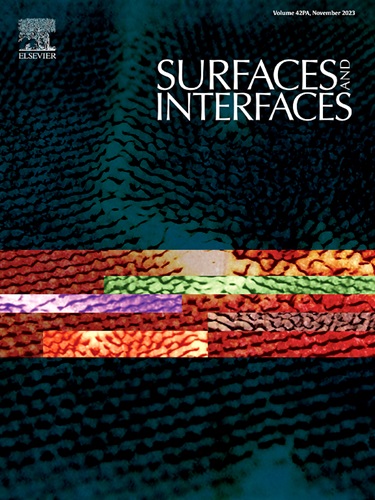纳米农药表面化学性质对植物角质层和蜡层吸附的影响:ZETA电位和润湿的作用
IF 6.3
2区 材料科学
Q2 CHEMISTRY, PHYSICAL
引用次数: 0
摘要
纳米杀虫剂在植物表面的吸附是决定其应用效果、持久性和生态影响的关键因素。在本研究中,我们系统地研究了七种不同纳米载体的表面化学性质对纳米杀虫剂吸附的影响:月桂酰精氨酸乙酯(ELA,阳离子型)、椰油酰胺丙基甜菜碱(CAPB,滋阴型)、吐温 80(TW80,非离子型)、β-环糊精(βCD)、十二烷基硫酸钠(SDS,阴离子型)、乳清蛋白分离物(WPI)和聚酰胺 407(PXL,非离子型)。楝树籽提取物中的 Azadirachtin 被用作示范农药活性成分。使用动态光散射、紫外可见光谱、静态接触角(SCA,θ)和 zeta 电位(ζ)测量对纳米农药进行了表征。利用胡椒叶(ζ = -11.6 mV)和蜡烛树蜡(ζ = -2.6 mV)薄膜分析了纳米载体化学成分对纳米农药吸附的影响。荧光显微镜用于量化纳米农药(带荧光团标记)在基底上的吸附情况。研究发现,纳米载体的选择对吸附行为有很大影响。带有 ELA 电晕的纳米农药是阳离子,其 zeta 电位为 ∼+19 mV,θ 为 ∼ 61°,对叶片角质层和蜡基质的亲和力最高,这归因于有利的静电相互作用力。相反,带有 SDS(ζ = -48 mV;θ = 45°)、WPI(ζ = -24 mV;θ = 54°)和 PXL(ζ = -31 mV;θ = 64°)电晕的纳米杀虫剂吸附力最小。这些发现表明,纳米农药悬浮液的润湿行为与纳米农药在植物和蜡表面的吸附之间存在微弱的相关性,而纳米农药的 zeta 电位与纳米农药的吸附之间存在很强的相关性。这些发现启发式地建议,水性阳离子和齐聚物纳米农药载体可在辣椒叶和蜡烛树蜡表面提供卓越的吸附特性。与具有相似 zeta 电位和润湿特性的短链双亲化合物相比,PXL 和 WPI 等水性大分子载体的吸附效果较差,这表明相对于短链而言,亲水性大分子的立体和渗透链效应阻碍了吸附。本文章由计算机程序翻译,如有差异,请以英文原文为准。

Influence of nanopesticide surface chemistry on adsorption to plant cuticle and wax layer: The role of zeta potential and wetting
Nanopesticidal adsorption on plant surfaces is a critical determinant of their application efficacy, persistence, and ecological impact. In this study, we systematically investigate the impact of surface chemistry on the attachment of nanopesticides for seven different nanocarriers: ethyl lauroyl arginate (ELA, cationic), cocamidopropyl betaine (CAPB, zwitterionic), tween 80 (TW80, nonionic), β-cyclodextrin (βCD), sodium dodecyl sulfate (SDS, anionic), whey protein isolate (WPI), and poloxamer 407 (PXL, nonionic). Azadirachtin from neem seed extract was employed as a model pesticide active ingredient. The nanopesticides were characterized using dynamic light scattering, UV–visible spectroscopy, static contact angle (SCA, θ), and zeta (ζ) potential measurements. Pepper leaves (ζ = −11.6 mV) and candelilla wax (ζ = −2.6 mV) films were utilized to analyze the effect of nanocarrier chemical composition on nanopesticide adsorption. Fluorescence microscopy was utilized to quantify the adsorption of nanopesticides (with fluorophore tagging) on the substrates. It was found that the choice of nanocarrier significantly influenced the adsorption behavior. Nanopesticides with ELA corona, which was cationic with a zeta potential of ∼+19 mV and θ of ∼ 61°, exhibited the highest affinity towards the leaf cuticle and wax substrates, attributed to favorable electrostatic interactions forces. Conversely, nanopesticides with SDS (ζ = −48 mV; θ = 45°), WPI (ζ = −24 mV; θ = 54°), and PXL (ζ = −31 mV; θ = 64°) corona demonstrated the least adsorption. These findings indicate a weak correlation between the wetting behavior of nanopesticide suspensions and nanopesticide adsorption on plant and wax surfaces, as well as a strong correlation between nanopesticide zeta potential and nanopesticide adsorption. These findings heuristically recommend that aqueous cationic and zwitterionic nanocarriers for pesticides provide superior adsorption characteristics on pepper leaves and candelilla wax surfaces. Aqueous macromolecular carriers such as PXL and WPI have performed less effectively in adherence compared to shorter chain amphiphiles with similar zeta potential and wetting characteristics, indicating that the steric and osmotic chain effects of hydrophilic macromolecules hinder the adsorption relative to shorter chains.
求助全文
通过发布文献求助,成功后即可免费获取论文全文。
去求助
来源期刊

Surfaces and Interfaces
Chemistry-General Chemistry
CiteScore
8.50
自引率
6.50%
发文量
753
审稿时长
35 days
期刊介绍:
The aim of the journal is to provide a respectful outlet for ''sound science'' papers in all research areas on surfaces and interfaces. We define sound science papers as papers that describe new and well-executed research, but that do not necessarily provide brand new insights or are merely a description of research results.
Surfaces and Interfaces publishes research papers in all fields of surface science which may not always find the right home on first submission to our Elsevier sister journals (Applied Surface, Surface and Coatings Technology, Thin Solid Films)
 求助内容:
求助内容: 应助结果提醒方式:
应助结果提醒方式:


